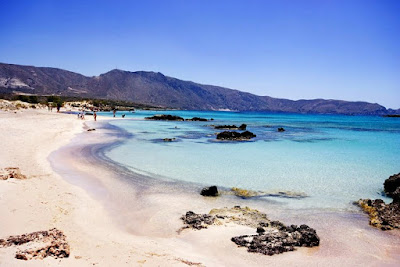

Friday 30 April 2010
Tuesday 27 April 2010
Thursday 22 April 2010
GORDES, FRANCE
Thursday 15 April 2010
METASEQUOIA: EAST MEETS WEST
 Metasequoia, a deciduous conifer, and one of the common fossils found in many of the Eocene sites of the Pacific northwest, flourished in Oregon's forests for millions of years. In honor of this long history, Oregon has named it their official state fossil.
Metasequoia, a deciduous conifer, and one of the common fossils found in many of the Eocene sites of the Pacific northwest, flourished in Oregon's forests for millions of years. In honor of this long history, Oregon has named it their official state fossil. Metasequoia were first described from the Mesozoic from Shigeru Miki in 1941. Miki, thinking they were long extinct was surprised that his 'fossil first' had living relatives. The "dawn redwood" was rediscovered in China in 1941 in Modaoxi. The excitement of the find was diminished by the heating up of World War II. In 1948, Wan Chun Cheng took up their study with fellow scientist, Hu Hsen Hsu, with a study and a replanting program.
Harvard University was asked to participate and brought back a collection of seeds and seedlings to distritute to various universities and arboreta worldwide. Today, the dawn redwood can be found growing in temperate environments across North America and the rest of the globe.
Two of my friends, Mike and Cory, raise these "fossil seedlings" for friends and paleo enthusiasts. Sadly, I tend to underwater for extended periods of time, which has disasterous effects even on this small study sample. Even so, several of the hardiest seedlings grace my yard, adding a bright, fresh green and Oregon's official fossil to the garden. This year, I've started a few new hopefuls of my own to plant on Earth Day.
Wednesday 14 April 2010
FOSSILES DANS LE BASSIN DE PARIS
Sunday 11 April 2010
Saturday 10 April 2010
ELAFONISI: ΠΑΛΑΙΟΝΤΟΛΟΓΙΑ

Nestled between the Aegean and Libyan Sea, Crete, the largest of the Greek Islands, sits at the southern most tip of Europe, the crossroad of cultures, civilizations, East and West, Africa and Europe.
The islands of the Aegean are peaks of underwater mountains that extend out from the mainland. Crete is the last of this range and boasts a diverse beauty from its high mountains of Psiloritis, Lefka Ori, Dikti, to its ocean caressed pink sand beaches.
Much of the island of Crete is Miocene and filled with fossil mollusks, bivalves, gastropods and their marine pals who lived 5 to 23 million years ago in these warm, tropical waters. One of the best collecting sites is the beachside haunt of Elafonisi, on the island’s southern tip, 43km from Kastelli and 76km from Chania.
Aside from the plentiful fossils in creamy pink limestone matrix, the beach is home to sun bathing locals and rare extant marine species. Pinniped Seals and Loggerhead Sea turtles call this part of the world home.
The fields are crimson, filled with lush, red Cretan Poppies. If you have a taste for something more remote, and venture into the local mountains, you’ll see wonderful folliage, exquisite orchids and deep in the forests the last remaining lynx, Roe Deer, Wild Goat and brown bear.
After a day of collecting, you can take in the vineyards to indulge in some fine cretan wine and local olive oil. Enough of either will inspire you to explore the local music scene with you doing a wobbly Pentozali impression by nightfall.
Where in the World:
Elafonisi (alternate spelling Elafonissi) on the southern tip of Crete, 43km from Kastelli and 76km from Chania. longitude 23o 30' 60" N, latitude 35o 15' 60" N
Getting there:
Both Aegean Airlines fly into Crete. If you stop to take in the monastery of Panagia Chrisoskalitissa, "Our Lady of the Golden Step," it is just a mere 6km further to the beaches of Elafonisi via a dirt road. If you are without a car, no worries, there is regular bus service to Elafonisi from Kasteli and Chania. Conveniently, the fossil exposures are easy to spot and a stones throw from the main bus stop.
There is so much more to say about Crete but I'll stop this adventure at Elafonisi. The island holds many mysteries and bountiful fossil finds, including the remains of Deinotherium giganteum, a massive 8 million-year-old mammal and primative relative of the elephants roaming the Earth today.
With an emormous large nasal opening at the centre of his skull, presumably to house a rather largish trunk, Deinotherium may be the inspiration behind the myth of the Cyclops, the one-eyed giant from Homer's famous Odyssey... but that is a tale for another day.
Tuesday 6 April 2010
PEREGRINE BEAUTY: BIRDS OF PREY
 Peregrine falcons (Falco peregrinus), are exquisite birds of prey.
Peregrine falcons (Falco peregrinus), are exquisite birds of prey. Reaching speeds of over 320 km/h (200 mph) they are worthy predators in the air and one of the fastest moving creatures on the planet.
Highly adaptable to hot and cold temperatures, they boast a breeding range that stretches from the icy cold Arctic tundra to the searing Tropics.
The Peregrine Falcon was added to the endangered species list back in the 1970's after their population took a beating from food sources contaminated with pesticides, DDT being the main culprit. With the ban of DDT and active breed and release programs, their numbers have significantly increased.
The very pretty female in this photo is Miss Shade. She weighs in at around 34 ounces, a wee bit larger than her male counterparts, a ratio true for most raptors.
Subscribe to:
Posts (Atom)
